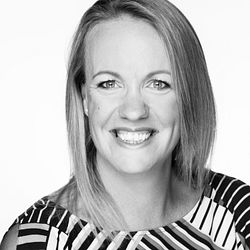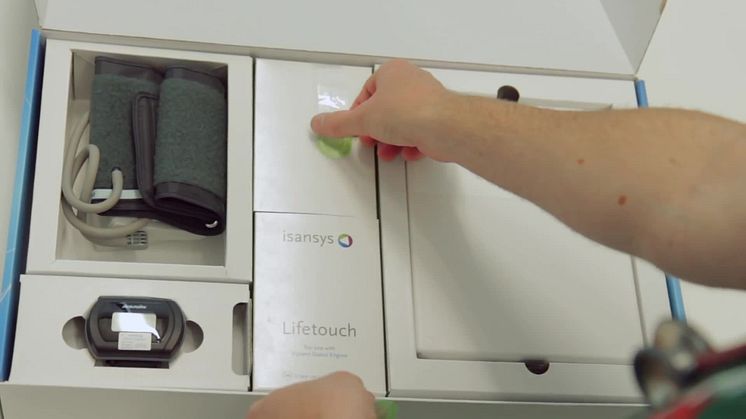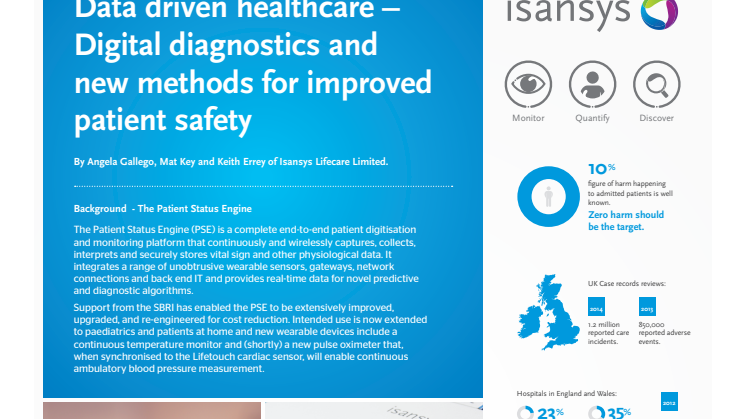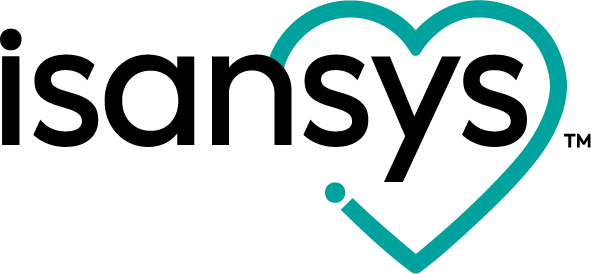
News -
COMING SOON - New data driven approach to healthcare
Isansys Lifecare Ltd, the provider of complete real-time physiological patient data services and systems, is this week celebrating its fifth anniversary.
In 2010, cofounders Keith Errey and Rebecca Weir set out with a vision to overcome barriers of technology integration and data accessibility in healthcare. They wanted to provide healthcare organisations with patient monitoring technologies and data analytics that would improve clinical decision making and patient outcomes, and reduce the costs of dealing with patient safety issues such as avoidable death and adverse events.
Over the course of the last five years, Isansys has made that vision a reality by creating a wireless patient monitoring system, called the Patient Status Engine (PSE). This provides a complete end-to-end platform to continuously and wirelessly capture, collect, interpret and securely store vital sign and other physiological data. The PSE incorporates a range of unobtrusive wearable sensors including the Lifetouch cardiac monitor, a wireless ‘smart patch’ that collects data directly from the patient and analyses every heartbeat to provide continuous heart rate, respiration rate and heart rate variability; the Lifetemp, a continuous wireless clinical thermometer, a continuous wireless pulse oximeter and a wireless blood pressure monitor.
Keith Errey, CEO of Isansys, said: “We launched Isansys at what was a pivotal time for healthcare professionals and organisations looking to benefit from the well-documented need of such systems to improve patient outcomes and reduce the number of adverse events, while simultaneously reducing the overall costs of healthcare.
Co-founder Rebecca Weir, now Director of Business Development, added: “We recognised that there was, and still is, a demand from busy healthcare professionals wanting to generate health benefits for their patients and economic benefits for their organisation. However, we learned that doctors and nurses were only open to new technologies if they provided robust, accurate and relevant data which would give them new insights into their patients’ health, and enable them to spend more time caring for those patients without involvement in the hassles and complexities of the technology and the regulatory burdens.”
Now, as part of its celebrations, the Oxfordshire-based company is getting prepared to launch the PSE2, its second generation wireless patient digitisation platform which incorporates the accumulated learning and feedback from hundreds of doctors, nurses and patients, and will significantly improve patient monitoring and provide the robust data and timely early warning indicators in hospital and at home, which both doctors and nurses were seeking.
As well as meeting the demands of the clinicians, the PSE2 will enable healthcare providers to better address those crucial patient safety issues that were the starting point of the Isansys journey: to reduce the number of avoidable deaths and adverse events in hospital, reduce lengths of stay, and enable new pathways to keep patients out of hospital in the first place.
The second generation platform which will be launched at the end of May, has been extended and the functionality has been increased with the help of a £1 million healthcare development contract awarded to Isansys at the beginning of 2015 by the Small Business Research Initiative (SBRI) Healthcare programme, which is part of a joint Innovate UK and NHS England initiative to enhance the adoption of innovative devices and new technologies.
The substantial SBRI Phase 2 contract followed the successful completion of two SBRI Phase 1 contracts in which Isansys demonstrated how the PSE could provide low cost, continuous, high resolution monitoring for all patients in hospital and extend high resolution monitoring out of the hospital into the patient’s home.
Keith said: “Remote monitoring systems that use wireless, sensing and information technologies to collect and analyse patient data show great promise in delivering better care, improving patient safety and enhancing clinical outcomes. These technologies not only help reduce the costs associated with avoidable patient deterioration, but they can reduce the number of medical errors and readmissions to intensive care wards and admissions (and readmissions) to hospital.”
Isansys has come a long way since it was first established five years ago.
Always realising the focus should be on clinical healthcare, rather than on tele-health monitoring of long-term chronic care patients, its founders, Keith and Rebecca, set up a trial at a hospital in the Netherlands. The hospital’s aim was to determine whether wearable vital sign monitors could provide the same information at the bedside as expensive monitoring equipment in an intensive care unit. Isansys was able to trial its Lifetouch cardiac ‘smart patch’ sensor and gain valuable experience in a clinical setting.
The success of these first trials in early 2011 provided Isansys with the knowledge that shaped the future direction of the company:
- The importance of working closely with doctors and nurses to discuss their problems and needs rather than trying to drive through a technology solution
- The need to ensure the wearable devices and the overall system were medically compliant by implementing full quality system and compliance processes from the very start of the company’s operation
- Recognition that, ultimately, it is a data service business rather than a medical device business – but the sensor devices must provide clinically validated, reliable and accurate data in order to bring real benefits to patients and providers.
Unable to find and purchase suitable devices, Isansys set up an in-house engineering team to develop the company’s first product, the Lifetouch. The Lifetouch was developed in accordance with what Keith and Rebecca call their philosophy of the ‘disappearing device’, a product that “disappears” in size, in cost, in complexity and, ultimately into the cloud. It was released as the first ‘cloud-ready’ medical device in May 2012 following approval as a Class IIa device under the European Medical Device Directive.
The ability to collect large physiological data sets led to clinicians asking how they could make better use of the data to improve outcomes for their patients. Isansys’ answer was to develop its PSE as a platform which would allow clinicians to acquire and analyse patient data in a clinical setting so they could grow the necessary evidence base.
Soon after, Isansys started working with leading clinicians in hospitals in the UK, including the Royal Free Hospital in London, helping them employ new patient monitoring technologies and predictive care methodologies in patients with advanced liver disease. Elsewhere the PSE was being used with paediatric patients to develop new early warning scoring systems and being readied for use with adult patients undergoing chemotherapy.
These studies were leading towards deployments which would address reported patient safety issues that 1.2 million adverse events occur each year in hospital settings, all of which cost the NHS more than £2 billion a year in lost bed days alone[1] and around £1.2 billion in litigation pay outs and fees.
In 2013, Isansys secured its first grant funding winning a £100,000 Smart Award funded by the Technology Strategy Board, (now Innovate UK.) to re-design and upgrade the Lifetouch for paediatric use.
In March 2014, Isansys secured two contracts from the NHS through SBRI Healthcare. These contracts allowed Isansys to expand the functionality of its CE-marked PSE in two key areas – improving patient safety in hospitals; and for cancer patients who have undergone chemotherapy. In the case of cancer patients, it is expected to provide early warning notifications of sepsis in patients at home, two or three days ahead of when they might present as emergency admissions.
In December 2014, Isansys secured the SBRI Phase 2 contract (see above) to continue its work in extending the functionality of the PSE, including the out-of-hospital patient surveillance.
Funding from these organisations, equity funding from angel investors, and the conviction and determination of its team members have seen Isansys rapidly expand in all areas including product development, manufacturing, marketing and sales, and regulatory. In the past 12 months, it has doubled its workforce from eight to 16 members.
The company has also won OBN’s Best New Medtech Development Programme award, deployed a range of products and systems within hospitals in the UK, and in India, and is getting ready to launch its second generation devices and systems in line with the next wave of market demand.
Over the years, Keith says Isansys has listened to providers and clinicians needs and created a precision monitoring platform which will not only continuously monitor their patients’ but collect highly relevant data which can be used for immediate or subsequent analysis. The clinicians and nurses can then use these predictive algorithms as new tools to see what is happening to their patient.
He said: “To create new devices and a complete intelligent platform that can collect such valuable and useable data, is CE marked and starting to be used as standard care in 5 years is a great achievement. Sometimes it seems like it has taken a long time but this is a necessary journey and rightly, any new technology or method intended for clinical use must show evidence of new benefits both clinically and economically, and this takes time. But in the end it’s worth it as we’re working on something that will lead to significant benefits for thousands, if not millions of individuals in the long term.
As Rebecca says: “Isansys isn’t just a technology company and we’re not just making medical devices here. We’re creating a platform and a service model which will change the face of healthcare as we see it, and, the exciting thing is, the more work we do on this, the more we recognise how important and profound this new data driven approach to healthcare is.”
Rory Morrison has worked with Isansys as a development engineer, since the company was first established. He was fresh out of university when he joined the business and knew he would have to learn fast to develop a system which was urgently needed in the healthcare arena.
He said: “At first, even getting two microchips to communicate seemed hard, and having a whole network of wireless sensors, let alone the infrastructure to process and store the data, seemed nigh-on impossible. However, it was exciting, challenging and stimulating, and what made it even better was knowing we were creating something which would make a huge difference.
“All along, Isansys’ goal has been to save patient’s lives and save the healthcare authorities money by providing clinicians with up-to-the-minute data. Now we're at a point where we are actually doing that.
“With the PSE2, we can bring precision patient monitoring to patients who would otherwise only be monitored a few times each day. Their clinicians can then use this data to predict patient outcomes, or know immediately when intervention may be necessary.
“At Isansys, we're only just starting to unlock the potential of what we can offer clinicians and nurses but we all know there’s so much more to come.”
To find out more about Isansys’ second generation systems, or to book a free demonstration, please log into www.isansys.com or call 01235 436229 for more information.



